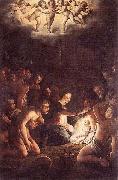Wholesale Oil Painting No Minimum |
|||||||||||
|
|
|||||||||||

|
|||||||||||
|
|
|
||||||||
Philippe de Champaigne1602-1674 Philippe de Champaigne Locations His artistic style was varied: far from being limited to the realism traditionally associated with Flemish painters, it developed from late Mannerism to the powerful lyricism of the Baroque. It was influenced as much by Rubens as by Vouet, culminating in an aesthetic vision of the world and of humanity that was based on an analytic view of appearances and on psychological truth. He was perhaps the greatest portrait painter of 17th-century France. At the same time he was one of the principal instigators of the Classical tendency and a founder-member of the Acadmie Royale de Peinture et de Sculpture. His growing commitment to the Jansenist religious movement (see JANSENISM) and the severe plainness of the works that it inspired has led to his being sometimes considered to typify Jansenist thinking, with its iconoclastic impulse, in spite of the opposing evidence of his other paintings. He should be seen as an example of the successful integration of foreign elements into French culture and as the representative of the most intellectual current of French painting. |
||||||||
|
|
||||||||
The Nativity
The Nativity Painting ID:: 384 |
1643
Musee des Beaux Arts, Lille 1643 Musee des Beaux Arts, Lille |
|||||||
|
|
||||||||
Barocci, FedericoItalian, 1535-1612 .Italian painter. The leading altar painter in Italy in the second half of the 16th century, he enjoyed a greater popularity and exerted a more profound influence on the art of his time than any of his contemporaries. His patrons included the Pope, Emperor, King of Spain and Grand Duke of Tuscany, and among his admirers were Lodovico Cigoli, Annibale Carracci, Rubens and Guido Reni. However, his work did not begin to receive the acclaim accorded that of Tintoretto or El Greco until the mid-20th century. Several factors have obscured his importance, notably the relative inaccessibility and scarcity of his painted works, most of which were done on commission for specific locations in remote parts of Italy (where they have remained), and the type of painting he produced, which was almost exclusively devoted to religious subjects. He executed very few easel paintings. No autograph example of his painted work has ever left Europe, the portrait of Quintilia Fischieri (c. 1600; Washington, DC, N.G.A.) and pair of portraits of Federigo Ubaldo, Prince of Urbino |
||||||||
|
|
||||||||
|
|
The Nativity
The Nativity Painting ID:: 9787 |
1597, oil on canvas, Museo del Prado, Madrid. 1597, oil on canvas, Museo del Prado, Madrid. |
||||||
|
|
||||||||
Arthur Devis1712-1787 English By 1728 he had left Preston, and the following year he was working in London for the Flemish topographical and sporting painter Peter Tillemans. There he specialized in landscape painting and copying various works in Tillemans studio after Marco Ricci, Giovanni Paolo Panini and Jan van Bloemen. Devis earliest known commission, Hoghton Towers from Duxon Hill, Lancashire (1735; priv. col., see 1983 exh. cat., no. 3), painted for Sir Henry Hoghton during a trip to Preston in 1734-5, shows Tillemans influence in its attention to detail and the use of thin, transparent paint. Thomas Lister with his Family (c. 1738; Chicago, IL, A. Inst.) demonstrates a similar interest in landscape, featuring the family group in Gisburn Park, Lancs. Devis had returned to London by 1742 and established himself as a painter of conversation pieces, with a studio in Great Queen Street. Roger Hesketh with his Family is typical of his work at this time; it shows how Devis transformed the intimacy of a Dutch 17th-century genre scene into an elegant interior with the group of sitters connected by formal, schematic gestures. Roger Hesketh stands apart, in a tastefully contrived pose, his legs crossed and right arm thrust inside his waistcoat. His son, Fleetwood, stands with his hand resting on a dog next to his wife, who is seated with an infant on her lap. The adjacent telescope, globe and marine paintings are intended to advertise Hesketh interest in astronomy and travel. |
||||||||
|
|
||||||||
|
|
The Nativity
The Nativity Painting ID:: 19100 |
1857-58
Oil and gold leaf canvas
Birmingham Museums and Art Gallery. 1857-58 Oil and gold leaf canvas Birmingham Museums and Art Gallery. |
||||||
|
|
||||||||
Nardo, Mariotto diNMItalian Painter, active ca.1394-1424 |
||||||||
|
|
||||||||
|
|
The Nativity
The Nativity Painting ID:: 19607 |
Approx. 1385
Tempera on wood panel
Vatican Picture Gallery. Approx. 1385 Tempera on wood panel Vatican Picture Gallery. |
||||||
|
|
||||||||
Federico BarocciItalian Mannerist/Baroque Era Painter, ca.1535-1612 |
||||||||
|
|
||||||||
|
|
The Nativity
The Nativity Painting ID:: 31307 |
nn07
1597
Oil on canvas, 134 x 105 cm
Museo del Prado, Madrid
nn07 1597 Oil on canvas, 134 x 105 cm Museo del Prado, Madrid |
||||||
|
|
||||||||
Federico BarocciItalian Mannerist/Baroque Era Painter, ca.1535-1612 |
||||||||
|
|
||||||||
|
|
The Nativity
The Nativity Painting ID:: 28126 |
mk61
1597
Oil on canvas
134x105cm
mk61 1597 Oil on canvas 134x105cm |
||||||
|
|
||||||||
ALBERTINELLI MariottoItalian Early Renaissance Painter, 1474-1515 Italian painter. Albertinelli's contribution to the Florentine High Renaissance was inspired by the work of FRA BARTOLOMMEO, and the two artists worked together in a partnership, their paintings appearing to be the product of a single hand. Albertinelli, however, always retained artistic independence, as is revealed in certain paintings that are eccentrically archaic and in others that show a preference for conventions more typical of the early Renaissance. |
||||||||
|
|
||||||||
|
|
The Nativity
The Nativity Painting ID:: 29026 |
mk65
Oil on panel
9 1/16x19 11/16in
Uffizi,Gallery
mk65 Oil on panel 9 1/16x19 11/16in Uffizi,Gallery |
||||||
|
|
||||||||
Fra Filippo LippiItalian 1406-1469 Fra Filippo Lippi Galleries Lippi was born in Florence to Tommaso, a butcher. Both his parents died when he was still a child. Mona Lapaccia, his aunt, took charge of the boy. In 1420 he was registered in the community of the Carmelite friars of the Carmine in Florence, where remained until 1432, taking the Carmelite vows in 1421 when he was sixteen. In his Lives of the Artists, Vasari says: "Instead of studying, he spent all his time scrawling pictures on his own books and those of others," The prior decided to give him the opportunity to learn painting. Eventually Fra Filippo quit the monastery, but it appears he was not released from his vows; in a letter dated 1439 he describes himself as the poorest friar of Florence, charged with the maintenance of six marriageable nieces. In 1452 he was appointed chaplain to the convent of S. Giovannino in Florence, and in 1457 rector (Rettore Commendatario) of S. Quirico in Legania, and made occasional, considerable profits; but his poverty seems chronic, his money being spent, according to one account, in frequent amours. Vasari relates some romantic adventures of Fra Filippo that modern biographers are not inclined to believe. Except through Vasari, nothing is known of his visits to Ancona and Naples, nor of his capture by Barbary pirates and enslavement in Barbary, where his skill in portrait-sketching helped to release him. From 1431 to 1437 his career is not accounted for. Portrait of a Man and Woman at a Casement , c. 1440 Metropolitan Museum of Art, New York City.In June 1456 Fra Filippo is recorded as living in Prato (near Florence) to paint frescoes in the choir of the cathedral. In 1458, while engaged in this work, he set about painting a picture for the convent chapel of S. Margherita of Prato, where he met Lucrezia Buti, the beautiful daughter of a Florentine, Francesco Buti; she was either a novice or a young lady placed under the nuns' guardianship. Lippi asked that she might be permitted to sit for the figure of the Madonna (or perhaps S. Margherita). Under that pretext, Lippi engaged in sexual relations with her, abducted her to his own house, and kept her there despite the nuns' efforts to reclaim her. The result was their son Filippino Lippi, who became a painter no less famous than his father. Such is Vasari's narrative, published less than a century after the alleged events; it is not refuted by saying, more than three centuries later, that perhaps Lippo had nothing to do with any such Lucrezia, and perhaps Lippino was his adopted son, or only an ordinary relative and scholar. The argument that two reputed portraits of Lucrezia in paintings by Lippo are not alike, one as a Madonna in a very fine picture in the Pitti gallery, and the other in the same character in a Nativity in the Louvre, comes to very little; and it is reduced to nothing when the disputant adds that the Louvre painting is probably not done by Lippi at all[clarification needed]. Besides, it appears more likely that not the Madonna in the Louvre but a S. Margaret in a picture now in the Gallery of Prato is the original portrait (according to tradition) of Lucrezia Buti. The frescoes in the choir of Prato cathedral, which depict the stories of St John the Baptist and St Stephen on the two main facing walls, are considered Fra Filippo's most important and monumental works, particularly the figure of Salome dancing, which has clear affinities with later works by Sandro Botticelli, his pupil, and Filippino Lippi, his son, as well as the scene showing the ceremonial mourning over Stephen's corpse. This latter is believed to contain a portrait of the painter, but there are various opinions as to which is the exact figure. On the end wall of the choir are S. Giovanni Gualberto and S. Alberto, while the vault has monumental representations of the four evangelists. The close of Lippi's life was spent at Spoleto, where he had been commissioned to paint, for the apse of the cathedral, scenes from the life of the Virgin. In the semidome of the apse is Christ crowning the Madonna, with angels, sibyls and prophets. This series, which is not wholly equal to the one at Prato, was completed by Fra Diamante after Lippi's death. That Lippi died in Spoleto, on or about the 8th of October 1469, is a fact; the mode of his death is a matter of dispute. It has been said that the pope granted Lippi a dispensation for marrying Lucrezia, but before the permission arrived, Lippi had been poisoned by the indignant relatives of either Lucrezia herself or some lady who had replaced her in the inconstant painter's affections. This is now generally regarded as a fable, and indeed, a vendetta upon a man aged sixty-three for a seduction committed at the age of fifty-two seems hardly plausible. Fra Filippo lies buried in Spoleto, with a monument erected to him by Lorenzo the Magnificent; he had always been zealously patronized by the Medici family, beginning with Cosimo de Medici. Francesco di Pesello (called Pesellino) and Sandro Botticelli were among his most distinguished pupils. The altarpiece Lippi painted in 1441 for the nuns of S. Ambrogio is now a prominent attraction in the Academy of Florence, and was celebrated in Browning's well-known poem. It represents the coronation of the Virgin among angels and saints, including many Bernardine monks. One of these, placed to the right, is a half-length portrait of Lippo, pointed out by the inscription perfecit opus upon an angel's scroll. The price paid for this work in 1447 was 1200 Florentine lire, which seems surprisingly large. Selfportait with pupilsFor Germiniano Inghirami of Prato he painted the Death of St. Bernard. His principal altarpiece in this city is a Nativity in the refectory of S. Domenico ?? the Infant on the ground adored by the Virgin and Joseph, between Saints George and Dominic, in a rocky landscape, with the shepherds playing and six angels in the sky. In the Uffizi is a fine Virgin adoring the infant Christ, who is held by two angels; in the National Gallery, London, a Vision of St Bernard. The picture of the Virgin and Infant with an Angel, in this same gallery, also ascribed to Lippi, is disputable. Filippo Lippi died in 1469 while working on the frescos Storie della Vergine (Scenes of the life of the Virgin Mary, 1467 - 1469) in the apse of the Spoleto Cathedral. The Frescos show the Annunciation, the Funeral, the Adoration of the Child and the Coronation of the Virgin. A group of bystanders at the Funeral includes a self-portrait of Lippi together with his son Fillipino and his helpers Fra Diamante and Pier Matteo d'Amelia. Lippi was buried on the right side of the transept. The frescos were completed by Filippino Lippi, who also designed the funerary monument for his father. Although it was commissioned by Lorenzo de Medici it was not actually made until 1490 by an unknown Florentine sculptor. |
||||||||
|
|
||||||||
|
|
The Nativity
The Nativity Painting ID:: 32075 |
mk78
Washington,
National Gallery of Art.
mk78 Washington, National Gallery of Art. |
||||||
|
|
||||||||
Fra Filippo LippiItalian 1406-1469 Fra Filippo Lippi Galleries Lippi was born in Florence to Tommaso, a butcher. Both his parents died when he was still a child. Mona Lapaccia, his aunt, took charge of the boy. In 1420 he was registered in the community of the Carmelite friars of the Carmine in Florence, where remained until 1432, taking the Carmelite vows in 1421 when he was sixteen. In his Lives of the Artists, Vasari says: "Instead of studying, he spent all his time scrawling pictures on his own books and those of others," The prior decided to give him the opportunity to learn painting. Eventually Fra Filippo quit the monastery, but it appears he was not released from his vows; in a letter dated 1439 he describes himself as the poorest friar of Florence, charged with the maintenance of six marriageable nieces. In 1452 he was appointed chaplain to the convent of S. Giovannino in Florence, and in 1457 rector (Rettore Commendatario) of S. Quirico in Legania, and made occasional, considerable profits; but his poverty seems chronic, his money being spent, according to one account, in frequent amours. Vasari relates some romantic adventures of Fra Filippo that modern biographers are not inclined to believe. Except through Vasari, nothing is known of his visits to Ancona and Naples, nor of his capture by Barbary pirates and enslavement in Barbary, where his skill in portrait-sketching helped to release him. From 1431 to 1437 his career is not accounted for. Portrait of a Man and Woman at a Casement , c. 1440 Metropolitan Museum of Art, New York City.In June 1456 Fra Filippo is recorded as living in Prato (near Florence) to paint frescoes in the choir of the cathedral. In 1458, while engaged in this work, he set about painting a picture for the convent chapel of S. Margherita of Prato, where he met Lucrezia Buti, the beautiful daughter of a Florentine, Francesco Buti; she was either a novice or a young lady placed under the nuns' guardianship. Lippi asked that she might be permitted to sit for the figure of the Madonna (or perhaps S. Margherita). Under that pretext, Lippi engaged in sexual relations with her, abducted her to his own house, and kept her there despite the nuns' efforts to reclaim her. The result was their son Filippino Lippi, who became a painter no less famous than his father. Such is Vasari's narrative, published less than a century after the alleged events; it is not refuted by saying, more than three centuries later, that perhaps Lippo had nothing to do with any such Lucrezia, and perhaps Lippino was his adopted son, or only an ordinary relative and scholar. The argument that two reputed portraits of Lucrezia in paintings by Lippo are not alike, one as a Madonna in a very fine picture in the Pitti gallery, and the other in the same character in a Nativity in the Louvre, comes to very little; and it is reduced to nothing when the disputant adds that the Louvre painting is probably not done by Lippi at all[clarification needed]. Besides, it appears more likely that not the Madonna in the Louvre but a S. Margaret in a picture now in the Gallery of Prato is the original portrait (according to tradition) of Lucrezia Buti. The frescoes in the choir of Prato cathedral, which depict the stories of St John the Baptist and St Stephen on the two main facing walls, are considered Fra Filippo's most important and monumental works, particularly the figure of Salome dancing, which has clear affinities with later works by Sandro Botticelli, his pupil, and Filippino Lippi, his son, as well as the scene showing the ceremonial mourning over Stephen's corpse. This latter is believed to contain a portrait of the painter, but there are various opinions as to which is the exact figure. On the end wall of the choir are S. Giovanni Gualberto and S. Alberto, while the vault has monumental representations of the four evangelists. The close of Lippi's life was spent at Spoleto, where he had been commissioned to paint, for the apse of the cathedral, scenes from the life of the Virgin. In the semidome of the apse is Christ crowning the Madonna, with angels, sibyls and prophets. This series, which is not wholly equal to the one at Prato, was completed by Fra Diamante after Lippi's death. That Lippi died in Spoleto, on or about the 8th of October 1469, is a fact; the mode of his death is a matter of dispute. It has been said that the pope granted Lippi a dispensation for marrying Lucrezia, but before the permission arrived, Lippi had been poisoned by the indignant relatives of either Lucrezia herself or some lady who had replaced her in the inconstant painter's affections. This is now generally regarded as a fable, and indeed, a vendetta upon a man aged sixty-three for a seduction committed at the age of fifty-two seems hardly plausible. Fra Filippo lies buried in Spoleto, with a monument erected to him by Lorenzo the Magnificent; he had always been zealously patronized by the Medici family, beginning with Cosimo de Medici. Francesco di Pesello (called Pesellino) and Sandro Botticelli were among his most distinguished pupils. The altarpiece Lippi painted in 1441 for the nuns of S. Ambrogio is now a prominent attraction in the Academy of Florence, and was celebrated in Browning's well-known poem. It represents the coronation of the Virgin among angels and saints, including many Bernardine monks. One of these, placed to the right, is a half-length portrait of Lippo, pointed out by the inscription perfecit opus upon an angel's scroll. The price paid for this work in 1447 was 1200 Florentine lire, which seems surprisingly large. Selfportait with pupilsFor Germiniano Inghirami of Prato he painted the Death of St. Bernard. His principal altarpiece in this city is a Nativity in the refectory of S. Domenico ?? the Infant on the ground adored by the Virgin and Joseph, between Saints George and Dominic, in a rocky landscape, with the shepherds playing and six angels in the sky. In the Uffizi is a fine Virgin adoring the infant Christ, who is held by two angels; in the National Gallery, London, a Vision of St Bernard. The picture of the Virgin and Infant with an Angel, in this same gallery, also ascribed to Lippi, is disputable. Filippo Lippi died in 1469 while working on the frescos Storie della Vergine (Scenes of the life of the Virgin Mary, 1467 - 1469) in the apse of the Spoleto Cathedral. The Frescos show the Annunciation, the Funeral, the Adoration of the Child and the Coronation of the Virgin. A group of bystanders at the Funeral includes a self-portrait of Lippi together with his son Fillipino and his helpers Fra Diamante and Pier Matteo d'Amelia. Lippi was buried on the right side of the transept. The frescos were completed by Filippino Lippi, who also designed the funerary monument for his father. Although it was commissioned by Lorenzo de Medici it was not actually made until 1490 by an unknown Florentine sculptor. |
||||||||
|
|
||||||||
|
|
The Nativity
The Nativity Painting ID:: 32076 |
mk78
Washington,
National Gallery of Art.
mk78 Washington, National Gallery of Art. |
||||||
|
|
||||||||
Konrad of Soest1370-1422 German Konrad Gallery |
||||||||
|
|
||||||||
|
|
The Nativity
The Nativity Painting ID:: 33357 |
mk86
1403
Mixed media on wood
73x56cm
Bad Wildungen,
St Nikolaus
mk86 1403 Mixed media on wood 73x56cm Bad Wildungen, St Nikolaus |
||||||
|
|
||||||||
Albrecht Durerb.May 21, 1471, Imperial Free City of Nernberg [Germany] d.April 6, 1528, Nernberg Albrecht Durer (May 21, 1471 ?C April 6, 1528) was a German painter, printmaker and theorist from Nuremberg. His still-famous works include the Apocalypse woodcuts, Knight, Death, and the Devil (1513), Saint Jerome in his Study (1514) and Melencolia I (1514), which has been the subject of extensive analysis and interpretation. His watercolours mark him as one of the first European landscape artists, while his ambitious woodcuts revolutionized the potential of that medium. D??rer introduction of classical motifs into Northern art, through his knowledge of Italian artists and German humanists, have secured his reputation as one of the most important figures of the Northern Renaissance. This is reinforced by his theoretical treatise which involve principles of mathematics, perspective and ideal proportions. His prints established his reputation across Europe when he was still in his twenties, and he has been conventionally regarded as the greatest artist of the Renaissance in Northern Europe ever since. |
||||||||
|
|
||||||||
|
|
The Nativity
The Nativity Painting ID:: 33512 |
mk86
c.1502-1504
Tempera on wood
155x126cm
Munich,Bayerische Staatsgemalde-sammlungen,Alte Pinakothek
mk86 c.1502-1504 Tempera on wood 155x126cm Munich,Bayerische Staatsgemalde-sammlungen,Alte Pinakothek |
||||||
|
|
||||||||
BURGKMAIR, HansGerman Northern Renaissance Painter, 1473-1531 German artist, famous for his paintings and woodcuts. A friend of D??rer, he studied in Strasburg and Venice, as well as Augsburg. He executed the woodcuts for Weißkunig and some of those in Teuerdank. His greatest works are the altar-pieces in Munich and Augsburg. |
||||||||
|
|
||||||||
|
|
The Nativity
The Nativity Painting ID:: 33515 |
mk86
1520
Oil on wood
105.5x70.4cm
Munich,Bayerische Staatsgemalde-sammlungen,Alte Pinakothek
mk86 1520 Oil on wood 105.5x70.4cm Munich,Bayerische Staatsgemalde-sammlungen,Alte Pinakothek |
||||||
|
|
||||||||
Piero della FrancescaItalian Early Renaissance Painter, ca.1422-1492 Italian painter and theorist. His work is the embodiment of rational, calm, monumental painting in the Italian Early Renaissance, an age in which art and science were indissolubly linked through the writings of Leon Battista Alberti. Born two generations before Leonardo da Vinci, Piero was similarly interested in the scientific application of the recently discovered rules of perspective to narrative or devotional painting, especially in fresco, of which he was an imaginative master; and although he was less universally creative than Leonardo and worked in an earlier idiom, he was equally keen to experiment with painting technique. Piero was as adept at resolving problems in Euclid, whose modern rediscovery is largely due to him, as he was at creating serene, memorable figures, whose gestures are as telling and spare as those in the frescoes of Giotto or Masaccio. His tactile, gravely convincing figures are also indebted to the sculpture of Donatello, an equally attentive observer of Classical antiquity. In his best works, such as the frescoes in the Bacci Chapel in S Francesco, Arezzo, there is an ideal balance between his serene, classical compositions and the figures that inhabit them, the whole depicted in a distinctive and economical language. In his autograph works Piero was a perfectionist, creating precise, logical and light-filled images (although analysis of their perspective schemes shows that these were always subordinated to narrative effect). However, he often delegated important passages of works (e.g. the Arezzo frescoes) to an ordinary, even incompetent, assistant. |
||||||||
|
|
||||||||
|
|
The Nativity
The Nativity Painting ID:: 42861 |
mk170
1475-1480
Oil on poplar
124.4x122.6cm
mk170 1475-1480 Oil on poplar 124.4x122.6cm |
||||||
|
|
||||||||
Lodovico MazzolinoItalian High Renaissance Painter, 1480-1528 |
||||||||
|
|
||||||||
|
|
The Nativity
The Nativity Painting ID:: 43022 |
mk170
circa 1510
Oil on wood
39.4x34.3cm
mk170 circa 1510 Oil on wood 39.4x34.3cm |
||||||
|
|
||||||||
Juan de FlandesFlemish-born Spanish Northern Renaissance Painter, ca.1460-1519 South Netherlandish painter, active in Spain. Nothing is known of his life or work before he went to Spain, where he is first mentioned in a document of 1496 as Juan de Flandes, a painter in the service of Queen Isabella of Castile. Treasury accounts confirm that he held this position until the Queen death in 1504. On arriving in Spain, he must have lived in Burgos, where he certainly met MICHEL SITTOW, another painter in the Queen service, who had been at the Castilian court since 1492. |
||||||||
|
|
||||||||
|
|
The Nativity
The Nativity Painting ID:: 43890 |
c. 1508-19
Oil on panel, c. 1508-19 Oil on panel, |
||||||
|
|
||||||||
Philippe de Champaigne1602-1674 Philippe de Champaigne Locations His artistic style was varied: far from being limited to the realism traditionally associated with Flemish painters, it developed from late Mannerism to the powerful lyricism of the Baroque. It was influenced as much by Rubens as by Vouet, culminating in an aesthetic vision of the world and of humanity that was based on an analytic view of appearances and on psychological truth. He was perhaps the greatest portrait painter of 17th-century France. At the same time he was one of the principal instigators of the Classical tendency and a founder-member of the Acadmie Royale de Peinture et de Sculpture. His growing commitment to the Jansenist religious movement (see JANSENISM) and the severe plainness of the works that it inspired has led to his being sometimes considered to typify Jansenist thinking, with its iconoclastic impulse, in spite of the opposing evidence of his other paintings. He should be seen as an example of the successful integration of foreign elements into French culture and as the representative of the most intellectual current of French painting. |
||||||||
|
|
||||||||
|
|
The Nativity
The Nativity Painting ID:: 51726 |
nn09
1643
OIl on canvas
207x116cm
nn09 1643 OIl on canvas 207x116cm |
||||||
|
|
||||||||
CHRISTUS, PetrusNetherlandish Northern Renaissance Painter, ca.1410-1473 |
||||||||
|
|
||||||||
|
|
The Nativity
The Nativity Painting ID:: 63975 |
1445 Wood, 130 x 97 cm National Gallery of Art, Washington The painter, a follower of Jan van Eyck, here illustrates the Biblical theme in terms of contemporary life in his native city of Bruges. Joseph, for example, is shown as a Flemish peasant who, realizing he is on holy ground, has removed his wooden clogs. Under the influence of Rogier van der Weyden, Christus has framed the scene with a sculptured archway, typical of late Gothic churches in Flanders. These simulated sculpture groups, depicting the stories in Genesis of man and his sin, illustrate the historical reason for the subject of the painting, the coming of Christ as the Redeemer. , Artist: CHRISTUS, Petrus , The Nativity , 1451-1500 , Flemish , painting , religious 1445 Wood, 130 x 97 cm National Gallery of Art, Washington The painter, a follower of Jan van Eyck, here illustrates the Biblical theme in terms of contemporary life in his native city of Bruges. Joseph, for example, is shown as a Flemish peasant who, realizing he is on holy ground, has removed his wooden clogs. Under the influence of Rogier van der Weyden, Christus has framed the scene with a sculptured archway, typical of late Gothic churches in Flanders. These simulated sculpture groups, depicting the stories in Genesis of man and his sin, illustrate the historical reason for the subject of the painting, the coming of Christ as the Redeemer. , Artist: CHRISTUS, Petrus , The Nativity , 1451-1500 , Flemish , painting , religious |
||||||
|
|
||||||||
MARTORELL, Bernat (Bernardo)Spanish Early Renaissance Painter, ca.1400-1452 |
||||||||
|
|
||||||||
|
|
The Nativity
The Nativity Painting ID:: 64693 |
1440s Panel Collection Lippmann, Berlin Borrass?was succeeded as central figure of the Barcelona school by Bernat Martorell, a painter in whom scrupulous attention to detail is combined with touches of poetry. In spite of the limitations of his empirical and conventional perspective, he was able to convey an impression of depth and space, and to give life to every element of his composition. Artist:MARTORELL, Bernat Title: The Nativity (detail), 1401-1450, Spanish , painting , religious 1440s Panel Collection Lippmann, Berlin Borrass?was succeeded as central figure of the Barcelona school by Bernat Martorell, a painter in whom scrupulous attention to detail is combined with touches of poetry. In spite of the limitations of his empirical and conventional perspective, he was able to convey an impression of depth and space, and to give life to every element of his composition. Artist:MARTORELL, Bernat Title: The Nativity (detail), 1401-1450, Spanish , painting , religious |
||||||
|
|
||||||||
|
|
||||||||
|
|
The Nativity
The Nativity Painting ID:: 65253 |
1400 Tempera on walnut, 41 x 29,5 cm Galerie mittelalterlicher ?sterreichischer Kunst, Vienna The artist of this painting is referred to as Master of Salzburg. In this picture the scene of the Nativity is represented according to an apocryphal story of the Gospel: the Virgin is reclining on her bed while two midwives are on the point of giving a bath to the Infant. The woman in green is taking the Child from His mother, while the other is taking care that the bathwater is at right temperature. The bath puts an emphasis on the human aspect of the divine Child and is a hint to baptism. Joseph is seated on the right-hand side deep in thought. He holds his staff with his left hand, and is supporting his head with his right hand. The ox and the ass at the manger in the back seem to warm the straw and the small cambric kerchief with their breath. In addition to some stylistic resemblances the painting is reminiscent in other respects too of the Trebon Master's picture of the same scene. In both pictures the composition is divided by the building of the stable, with the difference that here the supports of the stable look like the frame of the scene represented, and divide the surface into two parts and not into three. In both pictures the supporting pole, emphatically placed in the foreground, separates Joseph, who views the events from the back and plays a role similar to the spectator's. In this picture too we can see birds on the roof of the stable, but they are shaped more firmly and realistically (as are the figures) than in the work of the Master of Trebon. In spite of the simplicity of the presentation and the somewhat rugged shaping of the figures with their rather large heads the susceptibility of the International Gothic style to elegance and decorative patterns evinces itself in this painting too. The elegance can be seen in the buoyant lines of the draperies, and in the Virgin's mantle, which clings to her body as if it were wet; the decorativeness in the way in which the painter has used the opportunities inherent in the rustic surroundings, and brought into harmony the pattern of the thatched roof, the mat and the fence, which are made of similar materials, and there is an additional harmonious touch in the plaited hair of one of the midwives. As in a great many other pictures of the period the ground is exceedingly steep here; compared to the figures in the foreground the stable seems to be high, on the other hand the beam underneath the roof touches the animals' heads. Although the white piece of cloth between the two midwives-in all probability a napkin, another symbol of the human nature of Jesus-looks as though it were hovering, in fact it lies on the ground. All this is not surprising, since these forms do not convey space, they are meant, first and foremost, to fill up the surface of the picture. Artist: UNKNOWN MASTER, Austrian , The Nativity , 1351-1400 , Austrian , painting , religious 1400 Tempera on walnut, 41 x 29,5 cm Galerie mittelalterlicher ?sterreichischer Kunst, Vienna The artist of this painting is referred to as Master of Salzburg. In this picture the scene of the Nativity is represented according to an apocryphal story of the Gospel: the Virgin is reclining on her bed while two midwives are on the point of giving a bath to the Infant. The woman in green is taking the Child from His mother, while the other is taking care that the bathwater is at right temperature. The bath puts an emphasis on the human aspect of the divine Child and is a hint to baptism. Joseph is seated on the right-hand side deep in thought. He holds his staff with his left hand, and is supporting his head with his right hand. The ox and the ass at the manger in the back seem to warm the straw and the small cambric kerchief with their breath. In addition to some stylistic resemblances the painting is reminiscent in other respects too of the Trebon Master's picture of the same scene. In both pictures the composition is divided by the building of the stable, with the difference that here the supports of the stable look like the frame of the scene represented, and divide the surface into two parts and not into three. In both pictures the supporting pole, emphatically placed in the foreground, separates Joseph, who views the events from the back and plays a role similar to the spectator's. In this picture too we can see birds on the roof of the stable, but they are shaped more firmly and realistically (as are the figures) than in the work of the Master of Trebon. In spite of the simplicity of the presentation and the somewhat rugged shaping of the figures with their rather large heads the susceptibility of the International Gothic style to elegance and decorative patterns evinces itself in this painting too. The elegance can be seen in the buoyant lines of the draperies, and in the Virgin's mantle, which clings to her body as if it were wet; the decorativeness in the way in which the painter has used the opportunities inherent in the rustic surroundings, and brought into harmony the pattern of the thatched roof, the mat and the fence, which are made of similar materials, and there is an additional harmonious touch in the plaited hair of one of the midwives. As in a great many other pictures of the period the ground is exceedingly steep here; compared to the figures in the foreground the stable seems to be high, on the other hand the beam underneath the roof touches the animals' heads. Although the white piece of cloth between the two midwives-in all probability a napkin, another symbol of the human nature of Jesus-looks as though it were hovering, in fact it lies on the ground. All this is not surprising, since these forms do not convey space, they are meant, first and foremost, to fill up the surface of the picture. Artist: UNKNOWN MASTER, Austrian , The Nativity , 1351-1400 , Austrian , painting , religious |
||||||
|
|
||||||||
Girolamo RomaninoItalian High Renaissance Painter, 1484-1562 |
||||||||
|
|
||||||||
|
|
The Nativity
The Nativity Painting ID:: 89707 |
oil on panel
Dimensions Height: 265 cm (104.3 in). Width: 117.2 cm (46.1 in).
cjr oil on panel Dimensions Height: 265 cm (104.3 in). Width: 117.2 cm (46.1 in). cjr |
||||||
|
|
||||||||
Giorgio Vasari1511-74 Italian painter, architect, and writer. Though he was a prolific painter in the Mannerist style, he is more highly regarded as an architect (he designed the Uffizi Palace, now the Uffizi Gallery), but even his architecture is overshadowed by his writings. His Lives of the Most Eminent Architects, Painters, and Sculptors (1550) offers biographies of early to late Renaissance artists. His style is eminently readable and his material is well researched, though when facts were scarce he did not hesitate to fill in the gaps. In his view, Giotto had revived the art of true representation after its decline in the early Middle Ages, and succeeding artists had brought that art progressively closer to the perfection achieved by Michelangelo. |
||||||||
|
|
||||||||
|
|
The Nativity
The Nativity Painting ID:: 92672 |
Date c. 1546(1546)
Medium oil on canvas
ttd Date c. 1546(1546) Medium oil on canvas ttd |
||||||
|
|
||||||||
|
Giorgio Vasari 1511-74 Italian painter, architect, and writer. Though he was a prolific painter in the Mannerist style, he is more highly regarded as an architect (he designed the Uffizi Palace, now the Uffizi Gallery), but even his architecture is overshadowed by his writings. His Lives of the Most Eminent Architects, Painters, and Sculptors (1550) offers biographies of early to late Renaissance artists. His style is eminently readable and his material is well researched, though when facts were scarce he did not hesitate to fill in the gaps. In his view, Giotto had revived the art of true representation after its decline in the early Middle Ages, and succeeding artists had brought that art progressively closer to the perfection achieved by Michelangelo. The Nativity Date c. 1546(1546) Medium oil on canvas ttd |
||||||||
|
|
||||||||
|
Prev Next
|
||||||||
|
|
||||||||
|
Related Paintings to Giorgio Vasari :. |
||||||||
|
|
||||||||
|
CONTACT US |
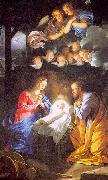

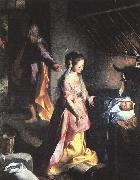
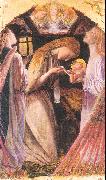

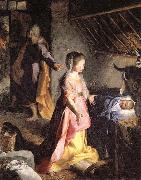
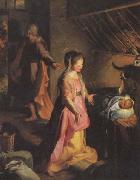


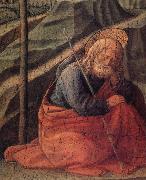
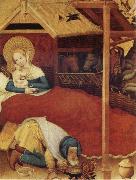
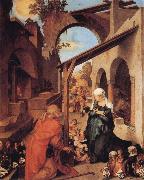
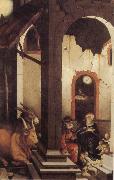
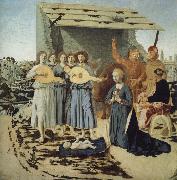

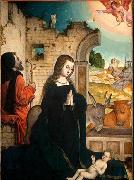
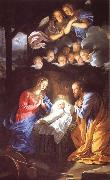
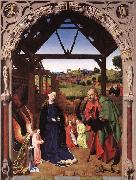
-272476.jpg)


